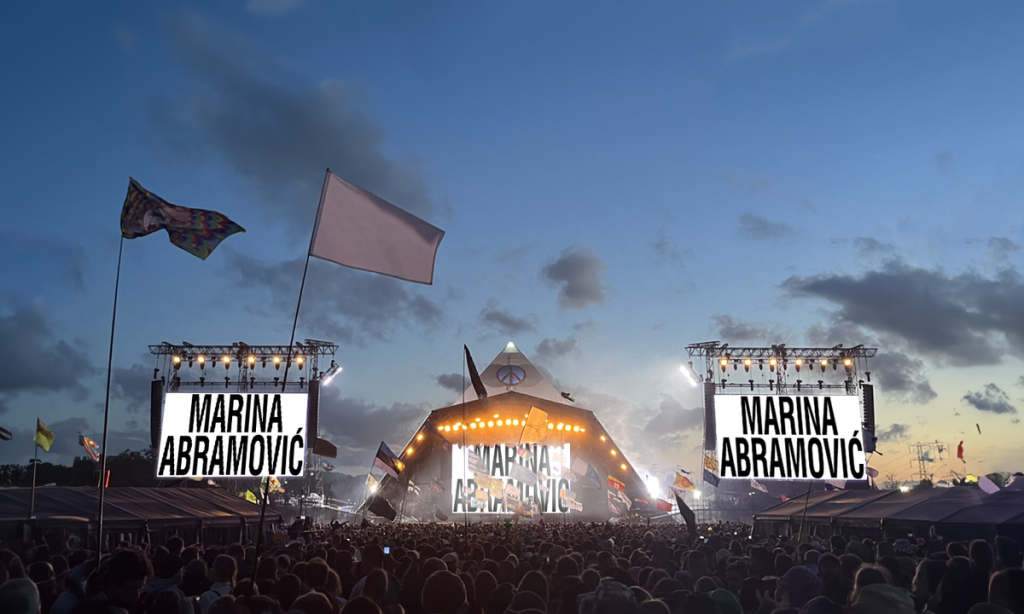Marina Abramović is expected to reach more people at once than ever before today (28 June) when the performance art grande dame takes to the Pyramid Stage at Glastonbury Festival and invites the crowd to participate in “seven minutes of collective silence”.
The mass participatory event, billed as the largest ever held by the artist, will “allow us to connect with ourselves and each other in ways words cannot,” Abramović claims. The event, scheduled to take place at 5:55pm, is organised by the London-based Cultural Institute of Radical Contemporary Arts (Circa). The collective silence ties in with the general festival theme this year of “peace”.
“I am terrified,” Abramović told The Guardian. “I don’t know any visual artists who have done something like this in front of 175,000 to 200,000 people. The largest audience I ever had was 6,000 people in a stadium and I was thinking ‘wow’, but this is really beyond anything I’ve done.”
Glastonbury, the world’s largest music festival, gets another art boost this year with a major public work by the US artist Hank Willis Thomas, on display opposite West Holts Stage. The sculpture, All Power to All People (2023), is an enlarged Afro pick with a clenched fist—associated with the 1960 and 70s Black Power movement—cast in patina bronze and protruding from the top.
Hank Willis Thomas’s All Power to All People at Glastonbury Festival marks the launch of Level Ground, a “new non-profit organisation aimed at revolutionising and democratising public art by prioritising inclusion and representation”, according to a project statement
Courtesy Level Ground
”This piece highlights ideas related to community, strength, perseverance, comradeship, and resistance to oppression… the Afro pick today exists as many things to different people; it is worn as adornment, a political emblem, and a signature of collective identity,” Willis Thomas says in a statement. The artist was a guest on The Art Newspaper’s podcast, The Week in Art, this week.
The Willis Thomas installation marks the launch of a new non-profit arts organisation, Level Ground, founded by Simon Vaughan and Ben Kearns. Level Ground is a “new non-profit organisation aimed at revolutionising and democratising public art by prioritising inclusion and representation”, says a project statement. Vaughan tells The Art Newspaper that that there is “not enough risk taking; we’re trying to remove the socio-economic barriers around public art”.
Vaughan says that the festival has given a small amount towards the Willis Thomas project. He and his business partner Ben Kearns’s have also invested their own funds, raised through their Creative Giants production agency. Their plan also involves selling the works on display at the festival via the auction house Christie’s, with proceeds reinvested in the Glastonbury art scheme. Other project partners include Goodman Gallery, Pace Gallery and Stephen Friedman Gallery.
Willis Thomas’s sculpture will, after Glastonbury, travel to Yorkshire Sculpture Park, UK, where the work will be on display until August 2025 as part of the Level Ground initiative (the piece was also included in the sculpture section of Frieze art fair in London last year).
According to Pace Gallery, which represents Willis Thomas, the artist examines “the structures, myths, and images that reinforce economic and racial prejudice, as exemplified by mass media, advertising, and popular culture”. His other public art pieces include a controversial memorial to the late civil rights leader Martin Luther King Jr and his wife, Coretta Scott King, which was unveiled in Boston, US, last year.
The Turner Prize winner Mark Wallinger is also due to show his film Threshold to the Kingdom (2000) at Glastonbury this year. The piece includes footage of people arriving at London City airport. Artforum reported in 2001: “On-screen, the airport doors open; singly or in small groups, incoming travellers (maybe weary, maybe relieved) slowly, weightlessly stride toward the camera and out of view. The images combine with the sharp compassion of Allegri’s setting of Psalm 51 to form an allegory with an overwhelming message: these travellers are dead.”


